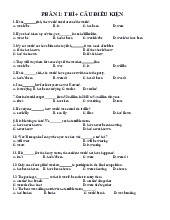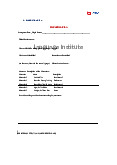




Preview text:
Class code: 231_71ENG610063_41
Student’s name: Le Anh Minh
Peer editor’s name: Hsu Shih Ying Date: 20/10/2023
WRITING ASSIGNMENT – LESSON 11 Unit: 10 Topic: 01
A lot of companies and organizations require employees to wear uniforms. Which kind of jobs
are uniforms suitable for? Are there any disadvantages to wearing a uniform to work? 1st draft
Many companies require their employees to wear specific clothes at work. They believe it
helps create a professional and unified look. However, this rule can have both positive and negative aspects.
Wearing the same outfits is a bit like how logos represent companies. For example, think
about airline flight attendants – their uniforms tell you which airline they work for. This
helps customers recognize the airline and builds a consistent image for the business.
One of the good things about these dress codes is that they make it easy to tell employees
apart, even if they do the same job. It also encourages everyone to keep their clothes clean
and well-kept. For instance, if men have to wear black suits, they tend to invest in shiny
shoes and neatly ironed shirts, which makes the workplace look more professional.
On the other hand, some people feel uncomfortable and restricted by these dress codes.
They prefer to choose what they wear. It's also important to consider different cultures and
religious beliefs. For example, in some places, women are not allowed to wear skirts in
public. Forcing them to do so for work can lead to disagreements and conflicts.
In conclusion, dress codes have their advantages, such as creating a professional image and
a consistent brand. However, they can also limit personal freedom and create cultural
problems. Employers should find a balance between enforcing dress codes and respecting
individual rights and cultural differences whenever possible. This way, a workplace can be
both professional and inclusive.
Self-assessment (checklist) Content
Y/N Comments/ Suggestions Task Response
Does the essay contain at least 250 words? Y
Is the topic addressed in the introduction? Y
Does the thesis statement discuss both questions as Y required?
Does the conclusion summarize the main points and Y
give the author’s final opinion?
Is each of the paragraphs related to the topic? Y
Coherence & Cohesion
Does the essay have an introduction, two body Y paragraphs, and a conclusion?
Is there a clear topic sentence in each paragraph? Y
Does the author include any relevant examples
and/or other supporting details (explanation, Y reasons, etc.)?
Are there at least 4 transitional expressions used Y
correctly (e.g. Moreover, However, In fact, etc.) Lexical Resource
Has the topic question been paraphrased properly? Y
Does the writer repeat the vocabulary? N
Are there any spelling errors? N
Does the essay contain vocabulary specific to the Y topic?
Grammar Range and Accuracy
Does the author use a range of simple, compound, Y and complex sentences?
Have the verb tenses and subject-verb agreement Y been checked?
Has punctuation been used correctly? Y Time management
Was the task completed within 40 minutes? N
Peer assessment (checklist) Content
Y/N Comments/ Suggestions Task Response
Does the essay contain at least 250 words? Y
Is the topic addressed in the introduction? Y
Does the thesis statement discuss both questions as Y required?
Does the conclusion summarize the main points and Y
give the author’s final opinion?
Is each of the paragraphs related to the topic? Y
Coherence & Cohesion
Does the essay have an introduction, two body Y paragraphs, and a conclusion?
Is there a clear topic sentence in each paragraph? Y
Does the author include any relevant examples
and/or other supporting details (explanation, Y reasons, etc.)?
Are there at least 4 transitional expressions used Y
correctly (e.g. Moreover, However, In fact, etc.) Lexical Resource
Has the topic question been paraphrased properly? Y
Does the writer repeat the vocabulary? N
Are there any spelling errors? N
Does the essay contain vocabulary specific to the Y topic?
Grammar Range and Accuracy
Does the author use a range of simple, compound, N and complex sentences?
Have the verb tenses and subject-verb agreement Y been checked?
Has punctuation been used correctly? Y Time management
Was the task completed within 40 minutes? N Final version
Many companies require their employees to wear specific clothes at work. They believe it
helps create a professional and unified look. However, this rule can have both positive and negative aspects.
Wearing the same outfits is a bit like how logos represent companies. For example, think
about airline flight attendants – their uniforms tell you which airline they work for. This
helps customers recognize the airline and builds a consistent image for the business.
One of the good things about these dress codes is that they make it easy to tell employees
apart, even if they do the same job. It also encourages everyone to keep their clothes clean
and well-kept. For instance, if men have to wear black suits, they tend to invest in shiny
shoes and neatly ironed shirts, which makes the workplace look more professional.
On the other hand, some people feel uncomfortable and restricted by these dress codes.
They prefer to choose what they wear. It's also important to consider different cultures and
religious beliefs. For example, in some places, women are not allowed to wear skirts in
public. Forcing them to do so for work can lead to disagreements and conflicts.
In conclusion, dress codes have their advantages, such as creating a professional image and
a consistent brand. However, they can also limit personal freedom and create cultural
problems. Employers should find a balance between enforcing dress codes and respecting
individual rights and cultural differences whenever possible. This way, a workplace can be
both professional and inclusive.



